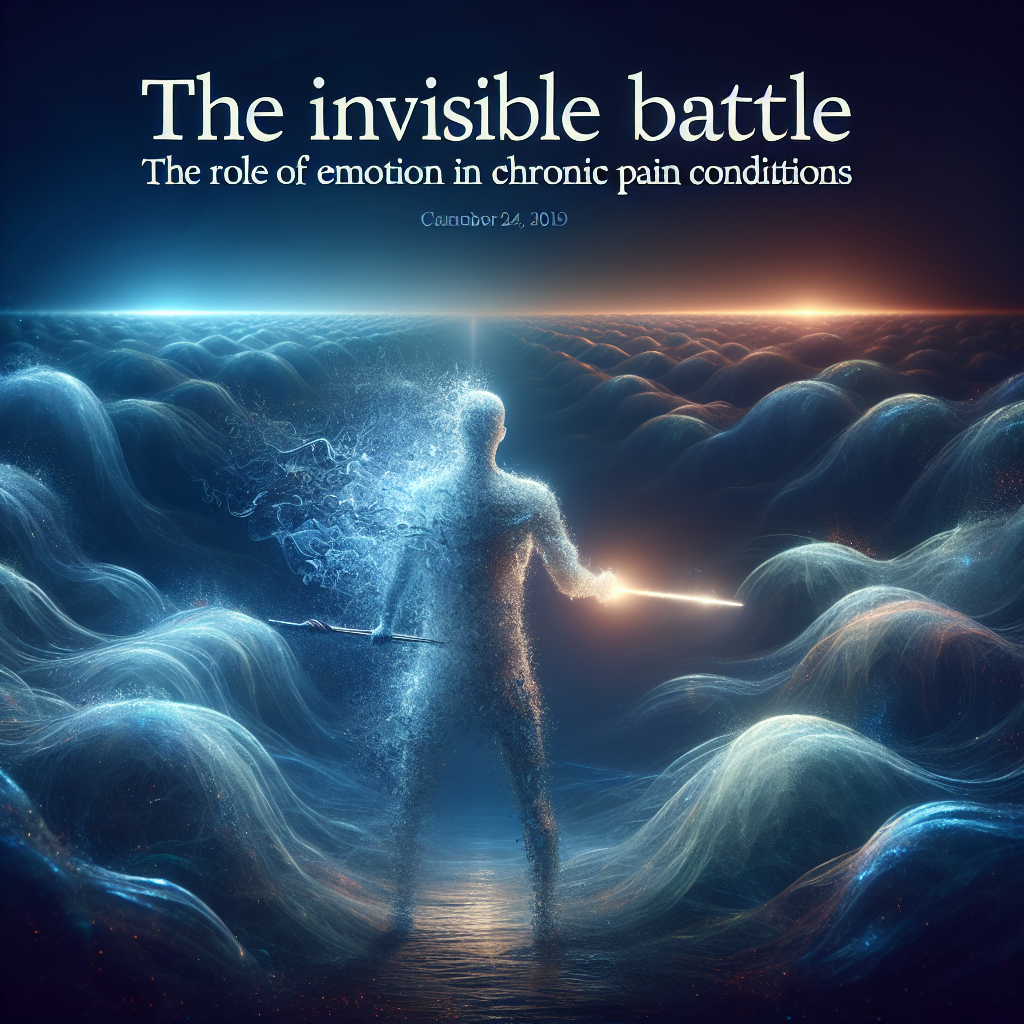
Introduction
Imagine living in a world where your body feels like it’s constantly under siege, yet no one can see the battle scars. This is the reality for millions suffering from chronic pain conditions. While medical treatments often focus on the physical symptoms, a profound aspect of these conditions tends to be overlooked: the emotional turmoil that accompanies chronic pain. In "The Invisible Battle: The Role of Emotion in Chronic Pain Conditions," we will delve into how emotions can influence the experience of pain, illuminate real-world case studies, and explore effective coping strategies. Together, we’ll discover how understanding the emotional component can transform pain management and enhance the lives of those affected.
Understanding Chronic Pain: The Invisible Landscape
Chronic pain is defined as pain persisting longer than three months, often without a clear cause. This pain can arise from various sources, including injury, illness, or even emotional stress. According to the American Academy of Pain Medicine, approximately 100 million Americans suffer from chronic pain, making it a significant public health concern.
The Physical and Emotional Connection
The relationship between physical pain and emotional distress forms a feedback loop. According to research, emotions like anxiety, depression, and anger can intensify the perception of pain. Conversely, chronic pain can lead to emotional struggles, trapping individuals in a cycle of suffering. Understanding "The Invisible Battle: The Role of Emotion in Chronic Pain Conditions" is essential for anyone grappling with this reality, as it underscores the importance of addressing both the physical and emotional dimensions of pain.
Case Study 1: Sarah’s Story
Background
Meet Sarah, a 35-year-old mother of two who developed chronic back pain after a car accident. Initially, Sarah sought physical therapy and pain medications, but her improvement plateaued. It wasn’t until a psychologist introduced her to cognitive-behavioral therapy (CBT) that she began to see real progress.
Analysis
Sarah’s journey illustrates how the emotional landscape can exacerbate chronic pain. Through CBT, she learned to identify negative thought patterns that fueled her pain and developed more constructive coping strategies. This case reinforces that "The Invisible Battle: The Role of Emotion in Chronic Pain Conditions" must be part of comprehensive pain management.
The Emotional Toll of Chronic Pain
Chronic pain is not just a physical challenge but an emotional one too. The stress of living with debilitating pain can lead to feelings of isolation, hopelessness, and despair. A study published in the Journal of Pain identified that individuals with chronic pain are 2-3 times more likely to experience anxiety and depression than those without.
Common Emotional Challenges
- Depression: The relentless nature of chronic pain can lead to feelings of sadness and worthlessness.
- Anxiety: Fear of the future, the unpredictability of pain, and concerns about identity can provoke anxiety.
- Anger: Frustration at the condition, societal misunderstanding, and lack of control can lead to anger.
Coping Strategies for Emotional Wellness
So, how can individuals navigate "The Invisible Battle: The Role of Emotion in Chronic Pain Conditions"? Here are proven strategies:
1. Mindfulness and Meditation
Mindfulness practices focus the mind and alleviate emotional distress. Research indicates that mindfulness meditation can reduce the perception of pain and improve emotional health.
2. Physical Activity
Gentle exercises, such as yoga or walking, have been shown to elevate mood and decrease pain perception. The release of endorphins during physical activities acts as a natural pain relief agent.
3. Support Networks
Connecting with others who understand your journey can significantly alleviate feelings of isolation. Support groups, whether in-person or online, create a shared sense of camaraderie.
4. Professional Mental Health Support
Therapies such as CBT, Acceptance and Commitment Therapy (ACT), or even medication for anxiety or depression may provide the support necessary for managing both emotional and physical symptoms.
5. Journaling
Expressive writing as a way to process emotions has been linked to lower pain levels and improved mental health. Keeping a pain journal that explores feelings can allow for emotional catharsis.
Case Study 2: Michael’s Journey
Background
Michael, a 42-year-old veteran with complex regional pain syndrome (CRPS), faced intensified pain due to significant emotional trauma from his military service. Initially resistant to therapy, he encountered difficulty managing both his pain and emotional state.
Analysis
His breakthrough came when he participated in group therapy that addressed PTSD alongside chronic pain. This integrated approach led him to better cope with both issues. Michael’s story underscores that failing to acknowledge "The Invisible Battle: The Role of Emotion in Chronic Pain Conditions" can hinder meaningful recovery.
The Science Behind Emotions and Pain
Understanding the biological underpinnings of the emotional-pain connection strengthens our grasp of "The Invisible Battle: The Role of Emotion in Chronic Pain Conditions."
Neurobiological Insights
The brain’s pain perception pathways are intertwined with emotional processing zones, such as the amygdala and prefrontal cortex. When chronic pain sets in, these connections can become hyperactive, amplifying both emotional distress and physical pain.
Emotions as Gatekeepers
The Gate Control Theory of Pain suggests that emotional states can influence the gates that open or close to pain signals. This theory aligns with the concept that emotional regulation can adjust pain perception.
Table: Emotional and Physical Symptom Interrelation
| Emotional Symptom | Influence on Physical Pain | Positive Coping Strategy |
|---|---|---|
| Anxiety | Heightens pain perception | Mindfulness Meditation |
| Depression | Lowers pain thresholds | Physical Activity |
| Anger | Can aggravate pain | Support Networks |
| Isolation | Increases pain perception | Professional Support |
Preventive Measures
To combat "The Invisible Battle: The Role of Emotion in Chronic Pain Conditions," proactive approaches can greatly enhance emotional resilience.
Stress Management
Implementing routines that prioritize stress relief – like deep breathing exercises or engaging in hobbies – can mitigate emotional reactions to pain.
Self-Advocacy
Educating oneself about chronic pain and discussing it with healthcare professionals helps establish a comprehensive approach to managing both emotional and physical symptoms.
Lifestyle Modifications
Adopting a healthy diet replete with anti-inflammatory foods slows bodily inflammation, potentially easing both pain and emotional distress.
Conclusion: Actionable Takeaways for Empowerment
In exploring "The Invisible Battle: The Role of Emotion in Chronic Pain Conditions," we have uncovered a vital component of chronic pain management. Addressing emotional wellness is not ancillary but essential for effective treatment. Understanding your emotional triggers and employing strategies can transform not just your approach to pain but your entire quality of life.
Take time each day to focus on your emotional wellness, cultivate supportive relationships, and advocate for your needs. Together, we can navigate this invisible battle toward a brighter and more empowered future.
FAQs
1. How do emotions influence chronic pain?
Emotions such as anxiety and depression can heighten the perception of pain, creating a cycle of worsening symptoms.
2. What can I do if I feel isolated due to chronic pain?
Join support groups, online forums, or engage in community activities to connect with others who understand your experiences.
3. Are there specific therapies that address both emotional and physical pain?
Yes, therapies like cognitive-behavioral therapy (CBT) or Acceptance and Commitment Therapy (ACT) help manage both emotional and pain symptoms.
4. How effective is mindfulness in pain management?
Studies show that mindfulness practices can significantly reduce the perception of pain and improve emotional well-being.
5. Is it important to discuss emotional issues with a healthcare provider?
Absolutely! Discussing emotional impacts can lead to more holistic treatment plans that address both pain and emotional health.
With this exploration of "The Invisible Battle: The Role of Emotion in Chronic Pain Conditions," you are now equipped to understand the intricate connection between emotional and physical experiences of pain. Together, we can cultivate resilience and compassion in this shared journey.

















